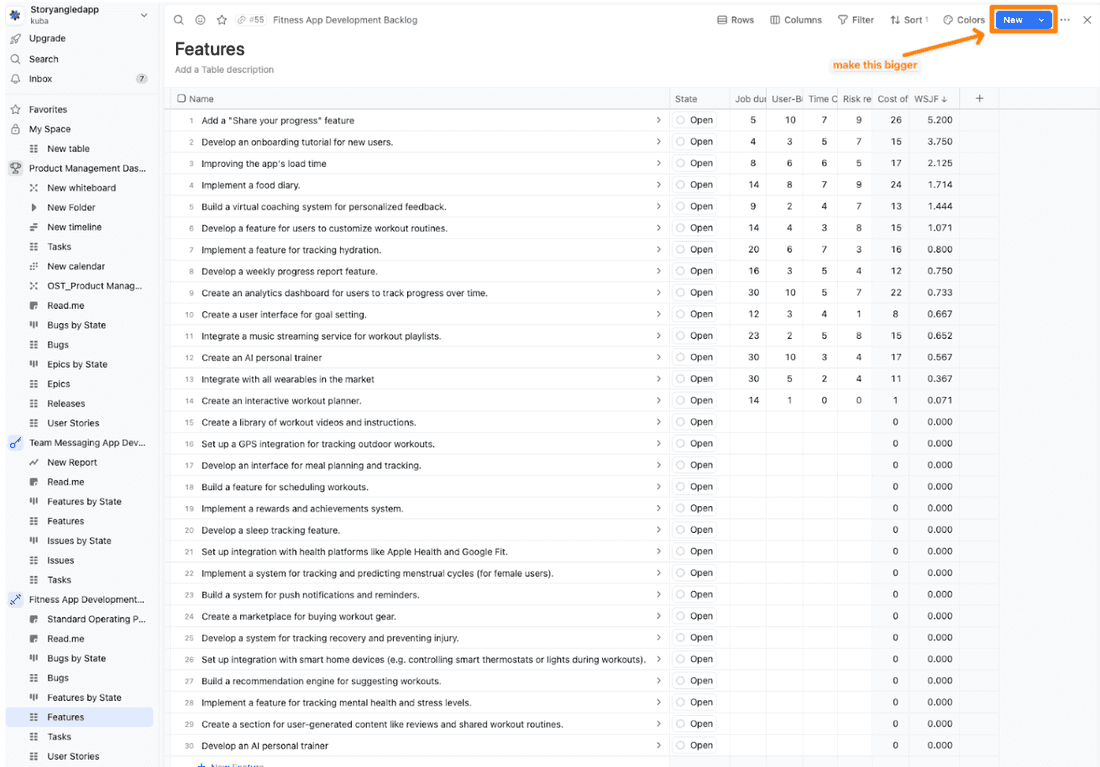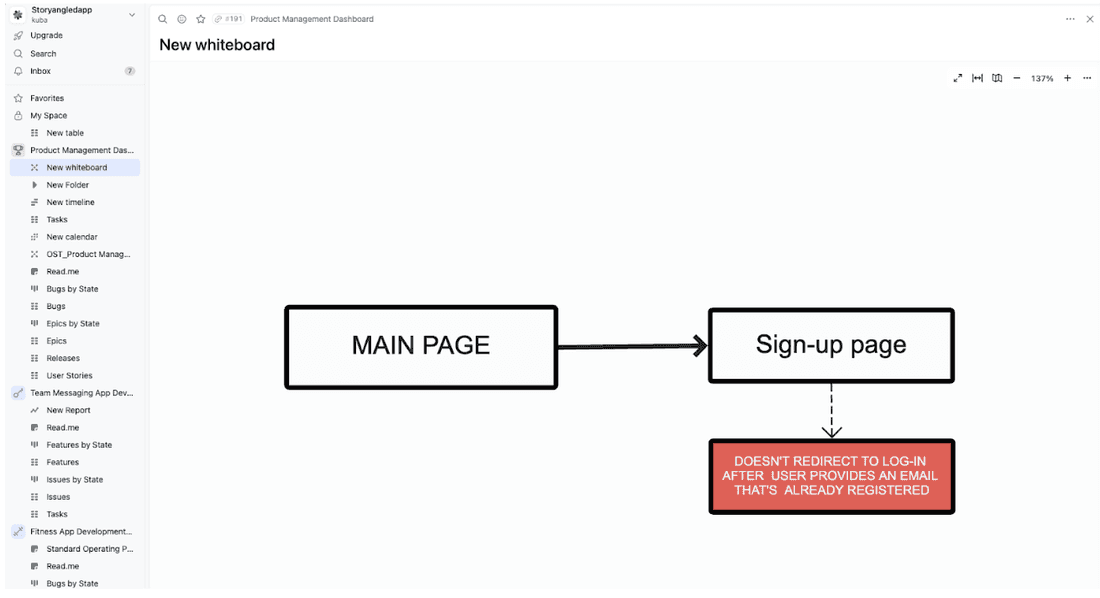What Is UAT Feedback? Definition, Best Practices, UAT Vs QA
What does UAT Stand for?
UAT stands for User Acceptance Testing. It’s the final stage of testing before releasing a product or feature to the market. It’s often called “end-user testing” or “application testing”, too.
It involves real users testing the product in a real-world environment to confirm it meets their needs, functions as intended, and delivers on the promised value.
Though usually used by the UX teams, UAT can bring many benefits to Product Managers’ jobs, too. This type of testing:
- Prevents costly mistakes: UAT reveals usability issues, bugs, or unmet requirements that were missed in earlier testing phases. Fixing these before launch dramatically reduces costs and time spent on post-release fixes.
- Ensures product-market fit: Direct user feedback aligns the product with actual market needs, boosting customer satisfaction and acceptance.
- Prioritizes user experience: UAT puts the user experience at the center and helps the Senior PM identify friction points to improve the overall user journey.
- Builds trust with stakeholders: Successful UAT demonstrates that the product is ready for release, building confidence and buy-in from stakeholders.
Why do User Acceptance Testing (UAT)?
Okay, but conducting UAT sounds like yet another plate on the already giant stack of Product Manager’s daily tasks.
The thing is: it’s actually worth it. Why?
- Identify hidden usability issues: Internal testing teams can become familiarized with a product, leading them to miss usability quirks that might frustrate actual users. By involving actual users in the testing process, UAT can help ensure that the product is easy to use and understand for everyone.
- Confirm alignment with real-world needs: UAT directly verifies whether the product solves the problems it was designed for. It ensures the team hasn’t drifted away from meeting the core user requirements over the course of development.
- Catch critical bugs: Even with a robust QA process, bugs impacting the end-user experience can slip through. UAT acts as a final safety net to find these issues before release.
- Boost overall quality: Issues found during UAT prevent post-release headaches, support tickets, and dissatisfied users. Fixing problems before launch saves time, money, and brand reputation.
- Gather valuable feedback: Users can provide insights that go beyond functionality and into the product’s feel, helping shape further development and improvements.
But UAT isn’t perfect in every scenario. Here’s when UAT might be less critical:
- Simple internal tools: If you’re building a tool for a small, internal team with limited complexity, the need for extensive UAT might be low. Thorough internal testing could suffice.
- Projects with rapid, iterative releases: If your product utilizes an approach focused on minor, frequent releases, UAT may be less formal. You can build in the feedback mechanisms directly into the development cycle rather than having a distinct UAT phase at the end.
QA vs UAT: the differences and when to choose what
Yep, you might’ve asked yourself already:
“How is UAT different from the usual Quality Assurance? Is this yet another buzzword?”
Well, not this time.
Here’s a breakdown of the key differences between Quality Assurance (QA) and User Acceptance Testing (UAT), plus guidance on when to choose each:
| Characteristic | QA | UAT |
| Focus | Technical correctness, meeting requirements | Real-world usability and fulfilling end-user needs |
| Who performs it | Internal testers and QA engineers | Actual end-users or clients |
| When in the SDLC | Throughout the development process | Final stages before release |
| Goal | Find and fix bugs, ensure technical quality | Validate if the product is ready for market and solves user problems |
QA vs. UAT: Focus
For QA, the focus is on preventing defects and ensuring the software meets technical requirements and quality standards.
UAT ensures the product meets the real-world needs and expectations of end-users.
For example, quality assurance might tell you there are no problems with your login sequence – the users are able to log into the app easily.
However, during the User Acceptance Testing you’ll discover that users expect to be able to invite other people from their team immediately after the sign up.
Product teams often overlook this slight difference. Just because your product works doesn’t mean it’ll work best for your customers.
QA vs. UAT: Who Performs It?
Engineers and testers usually perform quality assurance, either in a specialized team or as a part of their day-to-day work.
UAT involves actual end-users, stakeholders, or clients, in a staging environment. This gives you much more in-depth knowledge about how the product will perform once it actually goes live.
Typical questions during each phase of testing might look like this:
| QA | UAT |
| Are all inputs and buttons usable? | Do users understand what information they need to provide to sign up? |
| Does the signup process function properly? | Do they feel the signup process is logical and cohesive? |
| Are there any unexpected bugs for 2FA? | Are there any missing features during the onboarding process? |
QA vs. UAT: Types of Testing
Both testing phases differ significantly in the types of information you can get from them.
For Quality Assurance, types of testing include:
- Functional testing (testing individual features)
- Integration testing (how different components work together)
- Regression testing (ensure new code doesn’t break existing features)
- Performance testing
- Security testing
Each type delivers a different set of information about the product’s condition.
On the other hand, UAT includes:
- Alpha testing (early testing by select users in a controlled environment)
- Beta testing (wider group of users in their real environment)
- Operational acceptance testing (checking system readiness for deployment)
As you can see, UAT focuses much more on your product’s maturity stage. You’ll look at its entire performance, but it will happen after the product reaches the next growth level.
When to use QA vs. UAT
Quality Assurance should happen throughout the entire software development lifecycle (SDLC). But you need it most when you must:
- Rigorously test the technical functionality of the code
- Verify the product against specifications
- Identify defects during the development process
- Ensure compatibility, performance, and security
As we mentioned, UAT happens once your product development reaches alpha and beta stages. Then, you should use UAT to:
- Get users’ perspectives on the product’s usability
- Ensure the solution fits into real-world workflows and meets business needs
- Gain final acceptance from stakeholders before release
- Build confidence in the product’s ability to satisfy users
Remember, QA and UAT are complementary, not mutually exclusive. A successful product often benefits from both.
Also, if you live and breathe Agile, QA and UAT can be more iterative and integrated, with continuous testing throughout the development process.
How Senior Product Managers Can Lead UAT
Here’s a step-by-step guide on how you can conduct UAT as a Product Manager:
1. Define Clear Acceptance Criteria:
Work with stakeholders to outline specific, measurable criteria that the product must meet for UAT to be considered successful.
A great place to start is the bug documentation or user stories.
The key here is to link these criteria directly to the business objectives and the overall product vision.
2. Recruit the Right Testers:
You must be clear about whose feedback you want to incorporate into each testing phase.
Identify a diverse group of users that represent the target audience. Include:
- power users,
- users with technical knowledge
- users with different backgrounds and perspectives
This should give you a scope of insights wide enough to implement changes where you see fit (without feeling like you have to reinvent the entire product from scratch).
Also, consider compensation or incentives to ensure commitment.
3. Develop a Comprehensive Test Plan:
Here, you define what you want to test. Based on the acceptance criteria, create detailed test cases.
Of course, you need to prioritize the most critical product functionalities. But also, think of the overall business goals or product strategy goals you’re looking to achieve soon.
To make sure your test participants understand your intention, include explicit test scenarios and instructions for them.
3. Provide Necessary Support:
Offer resources, documentation, or training to help testers understand how to use the product.
This might be as simple as a short description of certain flows or features. Or as elaborate as developing interactive training materials or videos.
The overall goal is the same, no matter what:
You must equip the test participants with the information needed to provide valuable feedback.
4. Establish a Feedback Mechanism:
Use surveys, interviews, bug-tracking tools, or direct communication channels for feedback collection.
Allow your users to take screenshots and include their feedback using them:

This can help you understand the feedback immediately and serve as a great start to compiling in-depth documentation after the testing wraps up.
5. Analyze and Act on Feedback:
Categorize issues and prioritize fixes based on their severity and impact on user experience.
Communicate effectively with the development team on critical bugs and needed changes. Make sure to provide them with visuals and diagrams wherever possible to explain the exact problem the user communicated:

Remember to track the resolution of issues and retesting processes as well. You might use a space in Fibery you share with developers who take care of issues mentioned during testing.
6. Iterate and Improve:
After you gather all the insights from the UAT, analyze the results to glean insights into user behavior and preferences.
The whole point now is to use these insights to inform future product decisions and optimize the user experience.
Remember to communicate the results of implemented changes with other teams and the stakeholders. Highlight the success of your tests to get easier buy-in for future testing.
The PM’s Hot Take
Skipping User Acceptance Testing (UAT) is like trying to sail a ship without a map. It’s essential, not optional. UAT is your last line of defense against launching a product that misses the mark. It’s where you catch those bugs, fine-tune the user experience, and validate your product’s place in the market.
Think of UAT as the final reality check. It’s where theoretical functionality meets actual user satisfaction. Without it, you’re flying blind, relying on assumptions rather than insights. And let’s face it, the cost of post-launch fixes isn’t just about money—it’s about your product’s reputation and user trust.
So, here’s the deal: Embrace UAT. It’s not just another task; it’s your pathway to launching products that truly resonate with users. Use it wisely, and watch your products not just launch but soar.
Final Thoughts
By proactively leading and utilizing UAT, Senior Product Managers significantly boost the chances of building and releasing a product that meets customer needs, exceeds expectations, and achieves long-term market success.
Collaboration between teams results in the best testing. If you’re looking for a tool to help you organize product development, grab a free Fibery trial here.
Psst... Wanna try Fibery? 👀
Infinitely flexible product discovery & development platform.